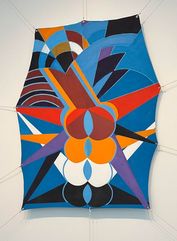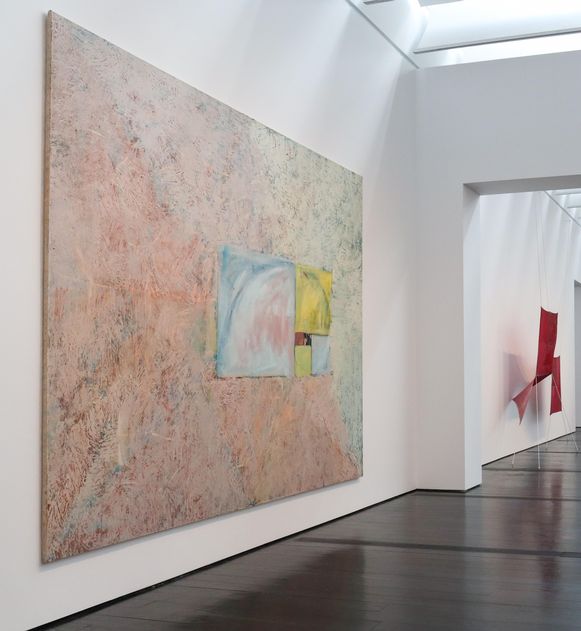- Sections :
- Crime & Public Safety
- Restaurants & Food
- Sports
- More
The Menil Collection Features 'Joe Overstreet: Taking Flight'
HOUSTON, TX -- The Menil Collection is a wonderful campus in Montrose, Houston, that houses incredible works of art from the ancient to modern times. Temporary exhibitions are always in play, which entices visitors and members to discover the new offerings, and keep the collection in their art viewing rotation. The newest gathering of pieces features the labors of Joe Overstreet, a Mississippi born Black man, now deceased, whose work spanned many decades, of which three are on display in ‘Taking Flight,’ a show to celebrate the man, and his obsession with: the abstract, shape, dimension, space, relationships, the female form, coition, Mother Africa, and the Civil Rights struggle. This exhibition marks the first time in three decades that the works have been displayed, and it has been fifty-three years since his paintings were shown at Rice University, at the behest of the Menil’s, in 1972, sixteen years before the museum collection building was even built.
As a young boy, Overstreet lived in a rural Mississippi area with a majority Native American population. He remembered a rather happy childhood spent in the countryside, and felt as he recalls very secure and well protected. His parents were essentially Black professionals, his father was an experienced bricklayer always with work always in demand, and his mother a teacher. The family migrated due to economic reasons, as a result of opportunities given by America’s entrance into World War II, following work that required his skills. Overstreet learned from his father and his trade, and incorporated some of his ideas into his own art with the differing shapes that he later developed. His college educated mother encouraged Joe to further develop his tendency towards art, while he inherited his fathers work ethic. The family finally settled in The Bay Area of California, where Joe flourished as a track athlete, but he was dead set on art. After his Merchant Marine service in 1956, Joe began his art apprenticeship in his early 20’s, and eventually established a San Francisco studio, taking ideas from the Harlem Renaissance, and learning from his mentors what it took to be an artist. He immersed himself in the Black Bohemian lifestyle, with his earliest works represented the outermost reaches of the music and public face. A move to New York in 1958, for him brought out the debauchery of the big city, and it reflected in his 1960’s art. Joe was a handsome man, tall, attractive; especially to different races and classes. His exploits reflected in his art, and ‘Carry Black,’ ‘Big Black, ’and ‘Strange Fruit,’ were most certainly painted from first-hand knowledge of the prived scenes.
A viewer cannot just stand, look, and go, with Overstreet’s offerings; they require examination to get their true meaning. Time is needed to adjust your sight to the light, to really take in what Joe is trying to say; to read the notes that he has written for the melody of his work. The turbulent 1960's brought about new concepts for Joe. He embraced Black Liberation, and the Civil Rights Movement with the right side of politics of the day, a time that required thinking outside of the box. Overstreet responded with ‘Untitled 1967,’ a shaped canvas piece that can remind you of a frog (remember the Budweiser Superbowl commercials?), a simple creature from the south, which were in abundance in the Mississippi of Overstreet’s youth. It was painted through the eyes of those that suffered the delirium, or dizziness, imposed by pessimistic experiences from those of a chalky nature. The boxed feet indicate the confinement of opportunities of his people at the time, and a willingness to box up your life with the pickets indicating a need to pick up sticks and leave the Deep South for more prosperous pastures. It would be later called The Great Migration.
Joe’s non-conformist attitude to the European laws of painting to a rectangular shape in the 1970’s, liberated Overstreet to explore another universe in expressing his desires on the canvas. It literally freed his art from the chains of the wall. Overstreet’s art took flight, in essence, he advanced a dimension, taking his acrylic canvases to the third; going way beyond the rectangle. Joe cuddles his work with differing shapes, some shield-like, others kite-like, or tent-like (tepee); figures a mathematician would love to solve for X. The intrinsic nature of his art expresses a hidden sensuality, almost orgy-like in comparison. He takes the body female and elevates it to new heights, taking the pudendum and expressing it as the very nature of life itself. The ou is just the depositor of seed, and seen in a secondary capacity, thus is relegated to the background, noted in different colors or shades. Examples of this can be seen in ‘Mandala,’ ‘Evolution.’ ‘Shadow and Light,’ all shield-like flying canvas, where representations of man and woman are most evident. Everything has meaning in Overstreet’s art. Even the taut cotton ropes used to tie down each piece of art has symbolism, with at least one, a noose knot; indicative of those used to lynch poor unfortunate souls during terror lynchings from 1877 to 1950, but can also have reference to The Vietnam War, which was a point consternation at that time. His tent piece, ‘We Came from There to Get Here,’ shows the horrors of strife that African Slaves endured on their journey from their African homes to The New World. Clear depictions of a man beaten down, a woman distressed after being violated, and a blue-on-blue symbol of Hope with a Crucified Christ.
Overstreet’s work shows the level of sacrifice that his ancestors had to endure, so that he could succeed as an artist in America. In the early 1990’s Joe visited Africa for an exhibition of his work at ‘Dak’Art 92,’ along with other American artists, in Dakar, Senegal. The two week tour changed him significantly. It symbolized the beginnings of the journey Overstreet’s ancestors had to suffer through, when they were sold into slavery by their African captors to European traders for transport to the Caribbean, then later America. Back in New York near Christmas 1992, Joe recalled, “I started painting and I painted for one year straight,” in maintaining a machine-like persistence for a new gratification, that centered around finding the meaning of himself and his ancestral homeland. The canvas measured 10’ x 12,’ the same dimensions as the cells his ancestors would have been confined in before their cross ocean voyage. Gone was his satyriasis, and the civil struggles of the 1960s. At 59, the desire to understand, ‘where did I come from,’ took hold, as it does for many of us, and so it was with Overstreet. It was at Goree Island, off the coast where Overstreet happened upon the place of destiny for many Africans, noting that thirty to forty people captured for enslavement would be confined to those dimensions forever etched in his mind, the future size of his ten 1993 canvases. The ‘House of Slaves,’ led to the ‘Door of No Return,’ and the trip was just as traumatic as a terrorized stroll to a Nazi Death Camp gas chamber, except Senegal’s human cargo would have to endure a living death on their voyage, of course many did not survive, yet if you survived everything, you had a life sentence of servitude ahead of you. That sacrifice of Overstreet’s ancestors that allowed them to beget life in The New World, that led to his birth, a miracle of chance which was not made in vain. Joe’s large oil on canvas work, ‘Cross Currents,’ 1993, represents the treacherous ocean journey of the enslaved, where again Overstreet returns to the boxes of his youth, representing the confinements of the time. The body is prostrate praying to an unknown higher being, asking, ‘why me?’ The colors are confused, not attuned to the strong African hues he has used in the past. The diagonal separation of scattered reds from east to the blues in the west, while the saffron, or yellow torso, of the figure represents sacrifice; and the quest for salvation which he learned in adapting the circular Hindu and Buddhist symbols of his earlier works.
Joe Overstreet was an extraordinary man, complex in his ways, making the art he understood, and not beholden to the traditions of any great European master nor any school. He was his own school; his own master, and his own apprentice. His body of work represents the phases of his life. From the young virile man, to the older gentleman, trying to make meaning of what he was experiencing. And one terrifying thought comes to mind in searching for all this meaning into Joe Overstreet. What if his ancestor had been the one who captured those destined for enslavement … Rather than being captured himself? We would have never known the brilliance of the man.
For more information: menil.org
Ruben can be reached at: ruben@montgomerycountynews.net



















